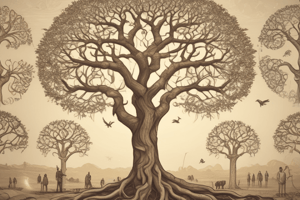Podcast
Questions and Answers
What type of structures are the bones in dolphins' flippers, bats' wings, horses' and cats' forelegs, and humans' bodies?
What type of structures are the bones in dolphins' flippers, bats' wings, horses' and cats' forelegs, and humans' bodies?
- Gene Conservation
- Analogous Structures (correct)
- Molecular Comparisons
- Homologous Structures
Which method is commonly used for contrasting organisms within a species or those that have diverged in a short amount of time?
Which method is commonly used for contrasting organisms within a species or those that have diverged in a short amount of time?
- Genome Phylogeny
- Mitochondrial DNA (correct)
- Gene Conservation
- Molecular Comparisons
What type of structures are the wing styles of bees, birds, and bats?
What type of structures are the wing styles of bees, birds, and bats?
- Molecular Comparisons
- Analogous Structures (correct)
- Homologous Structures
- Gene Conservation
What does a phylogenetic tree help to trace for a species?
What does a phylogenetic tree help to trace for a species?
Which parameter would indicate that two species are more related in a phylogenetic tree?
Which parameter would indicate that two species are more related in a phylogenetic tree?
In genetic terms, what signifies differences between species?
In genetic terms, what signifies differences between species?
Which parameter involves the existence of genes across multiple species, like the gene that codes for cytochrome proteins in ATP production?
Which parameter involves the existence of genes across multiple species, like the gene that codes for cytochrome proteins in ATP production?
'Monophyletic group' refers to a group of organisms that:
'Monophyletic group' refers to a group of organisms that:
'Paraphyletic group' differs from 'monophyletic group' in that it:
'Paraphyletic group' differs from 'monophyletic group' in that it:
'Polyphyletic group' differs from 'monophyletic group' in that it:
'Polyphyletic group' differs from 'monophyletic group' in that it:
Flashcards are hidden until you start studying
Study Notes
Clades and Phylogenetic Trees
- A clade is a group of organisms that shares a common ancestor and all of their descendants (both living and extinct).
- A phylogenetic tree is a diagram that shows the evolutionary relationships between different species.
Monophyletic Groups
- A monophyletic group is a group of organisms that are classified in the same taxon and share the most common recent ancestor (MCRA).
- A monophyletic taxon is also commonly known as a “clade”.
- A sample monophyletic group includes monkeys, apes, humans, and their last common ancestor.
Determining Evolutionary Relationships
- The relatedness of two species in a phylogenetic tree has significance, with species being more related if they have a more recent common ancestor.
- Species in a clade are said to be less related in the phylogenetic tree if they have a more distant common ancestor.
Types of Comparisons
- Molecular comparisons, such as those using mitochondrial DNA or gene conservation, can be used to determine evolutionary relationships.
- Homologous structures or traits, such as eyes and skeletal structure, can be used to determine evolutionary relationships.
- Analogous structures or traits, such as the arrangement of bones in dolphins' flippers and bats' wings, do not have a shared evolutionary history.
Hominidae Family
- Humans, bonobos, chimpanzees, gorillas, orangutans, and their extinct relatives belong to the Hominidae family of species.
- Chimpanzees and bonobos are our closest living relatives, based on the analysis of microRNAs from the family of great apes.
Studying That Suits You
Use AI to generate personalized quizzes and flashcards to suit your learning preferences.




